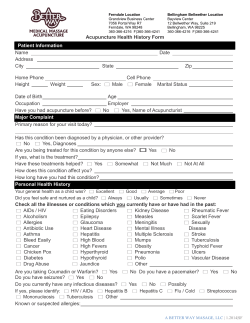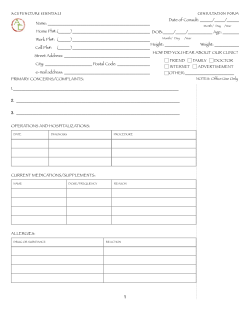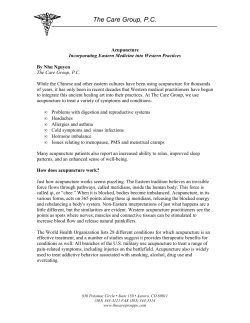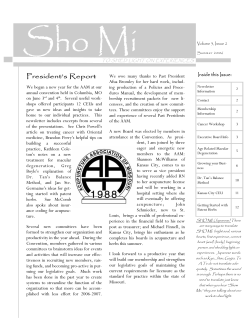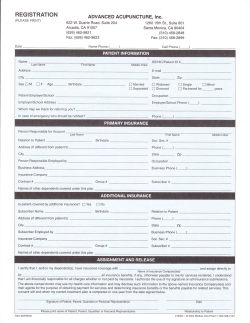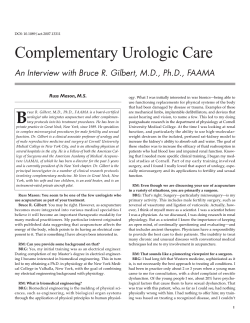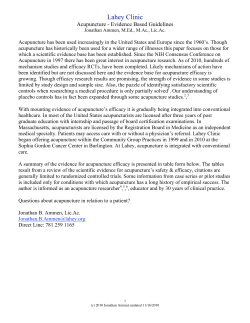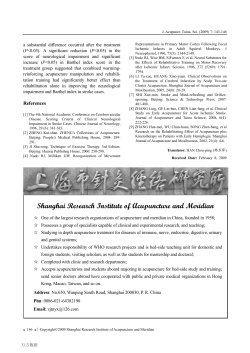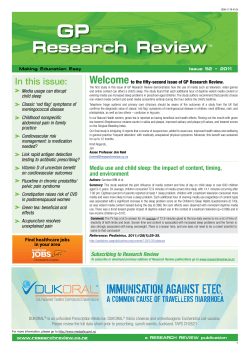
MERIDIAN WORLDWIDE October 2011 Editor: Charles Liggins
MERIDIAN WORLDWIDE October 2011 Newsletter of the International Acupuncture Association of Physical Therapists Editor: Charles Liggins EDITORIAL (Charles) The World Confederation of Physiotherapy held its four- yearly conference which commenced on Monday 20 June. The main programme did not include much subject matter related to acupuncture apart from some interesting posters, but the International Acupuncture Association of Physical Therapy (IAAPT) held meetings of interest. At the general meeting of IAAPT the following committee was elected: Chairman: Susan Putney, address 1320 Sunset Drive, RRs 1, Fort Erie, Ontario, L2A 5M4, Canada. Phone 001 905 991 8188, e-mail: SusanPutney@saintelizabeth.com Past Chairman: Karen Keith E-mail: karenkeith@gmail.com Vice Chairman: Vacant Secretary/Treasurer: Vacant. Temporarily: Lucy Ireland, 64B Gleniti Road. Timaru 7910, New Zealand Phone: 64 3 686 2900, E-mail: lucyflo@xtra.co.nz Public Relations: Apostolos G. Kairis, 1 Parthenonos & Poseiddonos Ave., P.Faliro, GR- 175 52, Athens, Greece. Phone: 30 210 98 34 277, E-mail: apolostolos@kairis.gr Education: Mary Pender, 4 Manor Street, Dublin 7, Ireland. E-mail mary.pender@ucd.ie Research: Karen Keith, P.O. Box 6242, Dunedin North 9010 New Zealand Phone: 64 3 471 2247. E-mail: karenkeithnz@gmail.com Newsletter: Charles Liggins, 31 Cunningham Road, Umbilo, Durban, 4001, South Africa. E-mail: charles.liggins5@gmail.com Dr Val Hopwood, 18 Woodlands Close, Dibden Purlieu, Southampton SO45 4JG, England. E-mail: val.hopwood@btinternet.com Committee Member: Sheila McNeill, Ballygawlly, Co Silco, Ireland. Phone 353 67 2459393. E-mail: Sheemac@eirecom.net WCPT Forum contact: Dr Val Hopwood. val.hopwood@btinternet.com IAAPT BREAKFAST NETWORKING MEETING This was held at 0700 on Wednesday 22 June, the meeting was chaired by Karen Keith. There were 34 present. Issues discussed 1. Does acupuncture need international standards for competency? How can these be applied? *How can we impose standards? Each country has regulations re needle use. Some cannot use needles as acupuncture but can do only (either/or) trigger point work or dry needling, wet needling (probably not physiotherapists), meridian therapy, shiatsu work, only acupressure. *Whatever we use needs to be evidence based. *South Africa has a dual registration system for acupuncture. *Maybe the standards should be called guidelines. 2. How do we impose evidence based practice? *Keep on doing research. *Publish case studies with references, discussion in Meridian Worldwide, local publications (journals/newsletters). *Have clinical guidelines but not recipes. 3. Scope of Application of Acupuncture *Tricky with scope of application of PT but now we have special interest groups of Women’s Health, Mental Health etc, does this endorse the use of acupuncture for these areas rather than just for pain, musculoskeletal and neuro? *IAAPT exists to support and advocate, to help subgroups lobby their national body to have conditions covered within the scope of practice. Again evidence based practice is important. *Use of dry needling/trigger point work and acupuncture per se needs to be defined, to be evidenced to convince the regulators that we can do what we do. 4. Training Standards *Suggestion: A. Basic: musculoskeletal, pain management (Western) B. More complex conditions C. Advanced (more TCM training) *Try to get some standardised hours for basic qualification amongst physiotherapy acupuncturists, (again legislative/country differences). 5. What are the current barriers to acupuncture use in various countries? *Legislation: Greece, Italy, Egypt, Holland, Venezuela. South Korea. *The WHO Acupuncture Guidelines are not accepted in some countries *IAAPT has a role to help countries to accept acupuncture. PRESENTATIONS During the Amsterdam conference IAAPT made presentations to two long serving committee members, namely Karen Keith our outgoing Chair person for all her hard work over the last few years, and Charles Liggins who received congratulations on completing twenty years of dedicated service to the IAAPT committee as editor of Meridian Worldwide. ~ Short Report from Val Hopwood World Congress for Physical Therapy held in Amsterdam, Netherlands Jun 20th-23rd 2011 This was a typical WCPT conference in many ways. Now a veteran of at least five of these four-yearly gatherings, I am used to the initially intimidating sheer size. This conference lasted for three full days with a huge trade exhibition and poster display area. It was attended by over 5,000 delegates. As is the way with these things I met many old colleagues, some from the other side of the world, representatives from the International Acupuncture Association of Physical Therapists, (IAAPT), the acupuncture sub-group of WCPT and others from local UK hospitals! The General Meeting was the largest ever, with 94 of the 106 member organisations in attendance and participating in decisions affecting the profession globally, including the adoption of a range of new policy documents. The keynote presentations and large general meetings have been welldescribed elsewhere so I will consider only the lesser sessions. Most importantly for acupuncture practitioners, the discussion meeting for IAAPT was well-attended with 37 interested representatives of their respective countries. A wide-ranging debate, considering safety issues, basic training and future progress was held with chairmanship of the organisation now passing from New Zealand to Canada for the next four years. News of IAAPT can be found on the WCPT website in the Forums section. You do not have to be a member to access and contribute to these discussions. The list below is a personal selection of some of the posters containing the word “acupuncture” and they proved to be a diverse and fascinating collection. All of these will have subsequently have been published on the WCPT website and will now be freely downloadable. COCHRANE SYSTEMATIC REVIEWS - ENABLING EVIDENCE-BASED PHYSIOTHERAPY AFTER STROKE Mehrholz J., Pollock A., Moseley A., States R. Number: FS-4 Tuesday 21 June 2011 08:30 Physiotherapy Volume 97 Supplement S1 Acupuncture is listed among the modalities considered but no convincing evidence is cited. DO SYSTEMATIC REVIEWS OF PHYSICAL AGENTS AND PHARMACOLOGICAL AGENTS IN THE COCHRANE LIBRARY INTERPRET SCIENTIFIC EVIDENCE DIFFERENTLY? Bjordal J.M., Demmink J.H. (Bergen) Number: RR-PL-3641 Tuesday 21 June 2011 16:00 Physiotherapy Volume 97 Supplement S1 Findings suggest that Cochrane review methodology is immature and that their review conclusions should be interpreted with caution. Scientific evidence is interpreted differently for physical agents and pharmacological agents in systematic reviews in the Cochrane Library. THE COST-EFFECTIVENESS OF ACUPUNCTURE AS AN ADJUNCT TO EXERCISE-BASED PHYSIOTHERAPY FOR OSTEOARTHRITIS OF THE KNEE Whitehurst D.G.T., Bryan S, Hay E.M., Thomas E., Foster N. (Keele UK) Number: RR-PO-202-28-Wed Wednesday 22 June 2011 13:00 Physiotherapy Volume 97 Supplement S1. This is the first UK cost-effectiveness study of acupuncture for OA and it supports the addition of acupuncture to advice and exercise within physiotherapy practice for the care of this patient group. Future clinical guidelines will be able to use this evidence about cost-effectiveness in making recommendations about the care of older adults with knee osteoarthritis. EFFECT OF ACU-TENS ON VESTIBULAR FUNCTION Jones A., Lai C.-H., Lam W. (Hong Kong) Number: RR-PO-203-14-Thu Thursday 23 June 2011 13:00 Physiotherapy Volume 97 Supplement S1 Results of this study suggest that Acu-TENS may be usefully employed to improve balance in people with vestibular disorders. Clinical application of Acu-TENS in patients with vestibular dysfunction warrants further investigation. QUANTIFYING NEEDLE PLACEMENT FOR A SPECIFIC ACUPUNCTURE POINT WITH RESPECT TO DE QI Keith K., Johnson G. (New Zealand) Number: RR-PO-203-3-Wed Wednesday 22 June 2011 12:00 Physiotherapy Volume 97 Supplement S1 The traditional use of de qi is as a subjective indication for needle depth. This novel research approach has important implications for understanding the microanatomy of acupuncture points and possible mechanisms for activation. Ultrasound has application in the research of the more superficially located acupuncture points and has potential to be incorporated with doppler imaging to better detail the neurovascular structures implicated in acupuncture. EXPERIENCES OF ACUPUNCTURE DURING AND AFTER TREATMENT FOR MIGRAINE Rutberg S., Öhrling K. (Luleå, Sweden) Number: RR-PO-203-7-Wed Wednesday 22 June 2011 12:00 Physiotherapy Volume 97 Supplement S1 Acupuncture treatment seems to relieve the consequences of migraine, increase emotional strength and make it possible to live life to the fullest and therefore it can be viewed as an alternative therapy for physiotherapists treating persons with migraine. The patient- therapist relationship seems to have importance for the experience of acupuncture and more research is needed to fully understand its meaning. BLINDING EFFECTIVENESS OF THE PARK SHAM ACUPUNCTURE DEVICE FOR THE UPPER AND LOWER LIMBS Tan C.-W., Santos D (Edinburgh, UK) Number: RR-PO-203-8-Wed Wednesday 22 June 2011 13:00 Physiotherapy Volume 97 Supplement S1 This study showed that the Park sham device appears to be effective in blinding the participants' between the real and sham needles in the lower limb (Bladder meridian) but not for the upper limb (Triple Energiser meridian) acupoints chosen for this study. PHYSIOTHERAPY MANAGEMENT OF PATIENTS FOLLOWING NECK DISSECTION FOR CANCER: A SYSTEMATIC REVIEW Overend T.J, Anderson C.M., Del Greco D.M., Mathews R.L., Potter N.K., Zhao A.X. (Ontario Canada) Number: RR-PO-210-25-Wed Wednesday 22 June 2011 12:00 Physiotherapy Volume 97 Supplement S1 There is evidence that progressive resistance exercise following neck dissection increases ROM and decreases shoulder disability. Acupuncture may also be effective in decreasing pain and dysfunction. More research is needed with this population to further our understanding of the optimal physiotherapy management of these patients. INTERNATIONAL SURVEY OF PHYSIOTHERAPISTS USING ACUPUNCTURE Hopwood V (UK) Number: SI-PO-309-12-Wed Wednesday 22 June 2011 13:00 Physiotherapy Volume 97 Supplement S1 Nearly all of the 720 replies to the open question “what has acupuncture added to your practice?” responded with variations on the theme of an additional and effective modality to treat both chronic and acute pain. Given the increasing and improving quality of acupuncture research; and the popularity of this technique world-wide, it is reasonable to suggest that some form of acupuncture training should be incorporated into orthodox physiotherapy education. ------------------------------------------------------------------------------------------Dr Val Hopwood FCSP NEWS FROM THE ACUPUNCTURE AND DRY NEEDLING GROUP – AUSTRALIA The Acupuncture and Dry Needling Group (ADNG) marks 2011 as its fourth year as a National Group within the Australian Physiotherapy Association. During 2011 group membership numbers have stabilized and the ADNG holds its place as the fourth largest special interest group in the APA after the MPA, SPA and PBA groups. State chapters have now been established in Victoria, New South Wales, Queensland, Western Australia and Tasmania. All states of Australia are represented on the ADNG National Committee. During 2010-2011 ADNG lecture evenings were held throughout Australia in venues including Sydney, Brisbane, Melbourne, Hobart, Perth and Adelaide. Various APA Dry Needling and Western Segmental Acupuncture courses were run in Western Australia, South Australia, Victoria, New South Wales and Queensland in 2009. The Level 1 Traditional Acupuncture Course, which has been taught with appropriate ongoing development since 1979, ran again in Sydney in the early half of 2011. Melbourne University and Griffin University continue to have Dry Needling units of study included in their post-graduate Doctorate and Master’s programmes respectively. Safety concerns continue to be reviewed by representation on the APA and Guild Risk Management Committee. The second ever ADNG two- day national conference will feature as part of the 2011 APA conference week in Brisbane at the end of October. The programme consists of a combination of national and international speakers and covers various presentation styles including lectures and workshops. Feedback from the conference in 2010 indicated that it was a resounding success and we hope to replicate this level of delegate satisfaction again. No doubt a positive aspect of ADNG conference is the national and international relationships that are formed between conference delegates and presenting physiotherapists and medical practitioners specialising in the field of acupuncture and dry needling. In the coming year the Chinese Medicine Board of Australia will be formally established in July 2012. Presently the Australian Physiotherapy Council is conducting a review of the requirement for physiotherapists and other allied health and medical practitioners to become endorsed to use the title of acupuncturist. The ADNG will be able to provide more information on the regulation of physiotherapy acupuncturists in the 2012 IAAPT report. Leigh McCutcheon ( Chairperson: APA ADNG) ~ NEWS FROM SOUTH AFRICA (Charles Liggins) Our group (the Acupuncture in Physiotherapy Group of the South African Society of Physiotherapy – APGSASP) remains in limbo with respect to basic acupuncture training and Continuing Professional Development (CPD). Physiotherapists who practice acupuncture in the country (apart from being members of the SA Society of Physiotherapy) are controlled by two Councils, namely the Health Professions Council of South Africa (HPCSA) and the Allied Health Professions Council of South Africa (AHPCSA). The latter council controls long term training in acupuncture and state that aspiring physiotherapy acupuncturists must do a full time degree course in the subject (5 years!) at the University of the Western Cape. Obviously no physiotherapist is prepared to go back to University for five years to become an acupuncturist. In addition to this problem the AHPCSA has not approved the commencement of CPD courses for any acupuncturists in South Africa, so those of us who want to extend our knowledge in the subject cannot do so in this country. During the last year the other council (HPCSA), in liaison with the SA Society of Physiotherapy, gave approval for physiotherapists with appropriate training in acupuncture to use it in their practice as long as it did not comprise more than fifty percent of any treatment session. In one test case one of our members who did the 80 hour basic course in the United Kingdom was certified as having the appropriate training. Currently, as Chairman of APGSASP, I am negotiating with the SASP to urge the HPCSA to allow us to commence CPD courses in acupuncture and then to approve an eighty hour basic course (similar to the one in the UK) to allow those physiotherapists, who wish to do acupuncture, to include it in their practice. Currently it is a matter of ‘watch this space!’ It is considered that, because of the above dilemma we have lost a large number of members from our group. Our membership for 2011 is 67. Phyllis Berger, one of the APGSASP committee members continues to make valuable contributions to this newsletter. Last year she attended the 13th World Congress on Pain held in Montreal, Canada. This is the world’s premier conference devoted to research and treatment of pain. This is what she had to say: ‘I was privileged to be invited to join the Scientific Programme Committee in 2008 for the above congress – it takes almost 2 years to prepare for the congress. My first meeting was in Vancouver in 2009 where the plenary and workshop/symposia were decided upon. Prior to the meeting members had to investigate the best researchers and speakers on their particular brief – mine being physiotherapy, acupuncture, complementary medicine and musculo-skeletal medicine. We had to invite these persons to submit their proposals and then evaluate their subject matter. This involved months of waiting for those selected to accept my invitation and then much reading thereafter! After this I then had to read and score (approval or not) the posters that were submitted on the above subjects. It was a wonderful experience to read what various researchers had achieved. I was particularly excited about the outcome of the programme as this was the first time that the International Association for the Study of Pain (IASP) had a plenary on acupuncture by the famous Professor J Han, and this was a most well attended and received lecture that demonstrated the great interest that acupuncture has achieved by therapists throughout the world, due to its success in pain management. I was then able to collate the topics for the Topical Symposium on complementary medicine with the acceptance of excellent speakers and those persons who had performed sound research and had published in peer reviewed journals – as you will read further on. It was wonderful to have speakers from the USA, UK and Germany who were able to meld their topics in alternative medicine together, and this too was a breakthrough of acceptance by many in the medical profession, judging by the high attendance of the conference delegates The congress delegates networked with – and heard from – thousands of the world’s leading experts on pain as they shared their thoughts, research and findings on this critical topic.’ CONFERENCE PLENARY SESSIONS ACUPUNCTURE ANALGESIA: CONSENSUS AND CONTROVERSIES. (J Han, NeuroSci.Res., Inst., Peking Univ. Hlth.Sci. Ctr, Beijing, China) Rearch conducted on humans and animal models showed that acupuncture can suppress pain sensitivity with a slow onset and exponential decay, suggesting a chemically mediated mechanism. The involvement of endogenous opioid peptides in acupuncture’s pain killing effect provided a reasonable and credible mechanistic background. The display of the neural pathways connecting some key brain regions, as evidenced by modern technologies, including brain - imaging studies, added considerable weight to the consensus of the basic research on acupuncture. Instead of manual needling, which is difficult to replicate, it seems more convenient to use electrical stimulation (electroacupuncture, EA) to dissect the underlying mechanisms. Thus, while low-frequency (2Hz) stimulation accelerates the release of enkephalin and Bendorphin, high frequency (100Hz) releases dynorphin, suggesting a frequency-dependent release of neuropeptides in the central nervous system. On the clinical trials, while the outcomes of the acupuncture groups are always better than the null group, they may or may not be superior to the ‘placebo’ group. The challenge for clinical researchers is to separate the physiological from the psychological components. Research on acupuncture may lead to the development of a safe, inexpensive, and yet effective way of modulating and strengthening homeostasis of the body functions. ANALYSIS AND OUTCOME MEASURES OF THE IMPLEMENTATION OF A 10 YEAR MULTIDISCIPLINARY COMPLEMENTARY AND ALTERNATIVE OUTPATIENT PROGRAM FPR CHRONIC PAIN PATIENTS. (D.Irnich, Multidisciplinary Pain Ctr., Dept. of Anaesthesiology, Univ. of Munich, Muenchen, Germany) Aim of Investigation: To evaluate a multidisciplinary outpatient program in complementary and alternative medicine (MOCAM) for chronic pain patients based on Traditional Chinese Medicine (TCM) and Classical Natural Medicine/Naturopathy (CNM). Methods: MOCAM consists of a four week outpatient program (phase 1) and a follow up program (phase 2 and 3). It includes methods of TCM (Acupuncture, Qigong, Tuina, and Dietetics), CNM (Phytotherapy, Breath therapy, Nutrition, Imagination, Body awareness) and education seminars (chronic pain, pain treatment, life style according to TCM and CMN) Emphasis is placed upon reinforcing patient confidence, self- understanding and self-responsibility. Outcome measures included pain intensity, health related quality of life (SF36), disability (PDI), return to work and number of doctor visits. Credibility of treatment and motivation (pain stages of change) were also evaluated. Results: 281 patients suffering from chronic pain were included. Mean duration of pain was 110 months. All outcome measures were significantly improved (t-test, P< 0.001) immediately and 2 years after completion of the 4 – week program compared to baseline. The credibility scale showed high values, motivation was a weak predictor. Conclusion: Complementary and Alternative Medicine can be an effective part of a multimodal treatment approach for chronic pain. POSITRON EMISSION TOMOGRAPHY AND MAGNETIC RESONANCE SPECTOGRAPHY AND THEIR APPLICATION IN TRANSLATIONAL ACUPUNCTURE RESEARCH IN FIBROMYALGIA. (R.Harris, Chr.Pain and Fatigue Res., Univ. of Michigan, Ann Arbor, MI, USA) Acupuncture has been in use for centuries to treat pain symptoms. However recent randomised controlled trials of acupuncture in chronic pain disorders have largely shown mixed findings. This is true for fibromyalgia (FM), a common functional pain disorder. Modern neuroimaging techniques such as positron emission tomography (PET) and proton magnetic resonance spectography (H-MRS) may provide insights into functional brain neurochemistry and the mechanism(s) underlying how pain patients respond to acupuncture. We performed two separate studies, one with PET and the other with H-MRS, wherein 23 FM participants were randomised to receive either nine acupuncture or nine non-skin penetrating sham acupuncture interventions over 4 weeks. Following acupuncture, PET revealed significant increases in mu-opioid receptor binding availability within the thalamus, cingulated, amygdala, caudate, putamen and dorso-lateral prefrontal cortex (all p<0.05 corrected). Acupuncture also resulted in decreases in glutamate levels within the posterior insula as assessed with H-MRS (p=0.03). These changes in opioid receptor binding and glutamate levels were largely absent in the sham group. These data suggest that acupuncture alters excitatory and inhibitory neurotransmitter systems in fibromyalgia patients. Furthermore they have implications on interpretation of acupuncture clinical trials. SYSTEMIC REVIEWS OF RANDOMISED CONTROLLED TRIALS OF ACUPUNCTURE FOR CHRONIC LOW BACK PAIN, HEADACHES AND OSTEOARTHRITIS OF THE KNEE. (M. Cummings, British Med. Acupuncture Society, London United Kingdom) Over the last ten years we have seen a surprising number of large clinical trials of acupuncture in chronic pain conditions published in high impact journals. This has resulted principally from three large research programmes conducted in Germany since October 2000, which investigated the efficacy, effectiveness, cost effectiveness and safety of acupuncture treatment (‘Modellvorhaben Akupuntur’). These programmes included some of the largest RCT’s of acupuncture ever performed – some were sham controlled, and some included conventional care arms. These trials have, for the most part, now been included in systematic reviews of acupuncture, and we can now start to make definitive recommendations to healthcare purchasers. However, there are still important questions to address over the interpretation of the research data, particularly how we address the very small benefits of acupuncture over penetrating sham procedures, and the substantial effects of the same sham procedures in comparison with usual care or the best conventional care. (Dr Cummings proceeded by reviewing the latest met-analyses and the largest RCT’s of acupuncture in chronic low back pain, headaches and osteo-arthritis of the knee). ~ The application of acupuncture in central sensitisation in neuropathic pain The following is a summary of Phyllis Berger’s excellent talk given at the Acupuncture in Physiotherapy Group of the South African Society of Physiotherapy Annual General Meeting at the end of March. The talk was entitled ‘She commenced by giving a detailed description of the epidemiology of neuropathic pain and elucidated the meanings of sensitisation and, particularly, centralisation. She then went on to give some clinical syndromes contributing to central sensitisation examples being, rheumatoid arthritis, osteo-arthritis, tempero-mandibular joint dysfunction, various musculo-skeletal dysfunctions – post whiplash, shoulder impingement syndromes, unilateral epicondylalgia, chronic radiating low back pain, chronic regional pain syndrome, post surgical pain and visceral pain, hypersensitivity syndromes eg irritable bowel syndrome, cardiac chest pain, chronic pancreatitis, endometriosis, chronic prostatitis and vulvodynia. The treatment strategy for the above is: *Reduce anxiety, stress, depression and improve mood. *Create endorphins locally and centrally. *Decrease inflammation locally and centrally. *Improve the immune system. *Reduce activity of the sympathetic nervous system. *Block aberrant nerve conduction locally and centrally. *Improve circulation. *Improve Quality of Life. She the posed the question: WHAT DOES ACUPUNCTURE DO TO THE BODY? (Quoting as reference: Acupuncture Analgesia: Areas of consensus and controversy. JS Han, Pain 2011, 152) *Acupuncture involves the peripheral sensory nerves and the afferent nerve pathway in the Spinal Cord. *Local trauma induced by a needle produces local adenosine, a neuromodulator with anti-nociceptive properties; this was released in experiments on mice (Goldman, Chen, Fujita et al 2010) *Adenosine interacts with the A1 receptor located on nearby afferent nerves, interfering with the local transmission of nociceptive signals – reducing inflammatory and neuropathic pain behaviour. *Acupuncture analgesia is mediated mainly by A-beta fibres and part of A-delta fibres. *The Gate Control Theory of stimulating the thick A-beta fibres to suppress the thin fibre transmission is relevant to both acupuncture and TENS. *Acupuncture’s analgesic effect can reach distant sites – eg electroacupuncture on distal body parts can effectively treat tension type headache *Non-segmental acupoints can be as effective as segmental points eg St36 for suppressing post-operative wound pain (eg after Caesarean). *Diffuse Noxious Inhibitory Control (DNIC) – high intensity stimulation is required for activation of C-fibres. *The analgesic effects of acupuncture (opioidergic) can be reversed with naloxone. *2Hz electrical stimulation releases endorphins and enkephalins; 100 Hz favours dynorphins; combining these frequencies may have an increased analgesic effect. ~ SHORT EXTRACTS FROM RECENT ACUPUNCTURE JOURNALS Acupuncture reduces crying in infants with infantile colic Conclusion: Minimal acupuncture shortened the duration and reduced the intensity of crying in infants with colic – further research using different acupoints, needle techniques and intervals between treatments is required. The procedure: The infants allocated to have acupuncture received minimal, standardised acupuncture with a sterilised disposable needle (0.20 x 13 mm) which was inserted unilaterally to a depth of 2 mm at point LI4 of the hand’s first dorsal interosseous muscle, a point often used in clinical practice when treating infants with colic. Left and right hands were used alternately. The programme consisted of a total of six bi-weekly visits to the acupuncture clinic. (Reference: Kajsa Landgre, Nina Kvorning, Inger Hallstrom: Acupuncture reduces crying in infants with infantile colic: a randomised, controlled, blind clinical study. Acupuncture in Medicine, December 2010, P174-179). Acupuncture for Endometriosis pain. Conclusion: Two groups of patients with endometriosis pain were compared, each received two series of 10 acupuncture treatments, twice a week over a period of five weeks. The two groups were then crossed over. Group 1 (n=47) received real acupuncture during the first series and Group 2 (n=54) received non- specific acupuncture. The real acupuncture group were needled at points BL32, ST29, ST36, CV3, SP6 plus up to three extra points according to traditional diagnosis – LR3, LR8, SP9 and 10 and KI10. Deqi was elicited and needles were stimulated manually or heated with moxa. The control group received needling at ‘non specific’ points namely PC9, GB31, LU1 and ST8, with no needle stimulation. Results were obtain from 83 of the 101 participants in the study–the real acupuncture group showed a significant reduction of pain intensity after the first ten treatments but group 2 patients showed significant pain relief after the crossover to real acupuncture. (Reference: Rubi-Klein K, Kucera-Sliutz E, Nissel H. et al: Is acupuncture in addition to conventional medicine effective in pain treatment for endometriosis? A randomised, controlled cross-over trial. Eur.J. Obstet Gynecol Reprod Biol, 2010: 153: 90-93.) The effect of acupuncture on postmenopausal symptoms (including hot flushes) Conclusion: Acupuncture was effective in reducing menopausal complaints when compared to sham acupuncture and can be considered as an alternative therapy in treatment of menopausal symptoms. The acupuncture group received traditional Chinese medicine acupuncture twice a week for a total of 10 sessions. Sterile, disposable needles of 0.25 x 25 mm were used. The needles were inserted bilaterally at four acupuncture points (ST36, depth 1 cun, LI4, 0.5 cun, KI3, 0.2 cun and LR3, 0.3 cun) in addition extra point HN3 at 0.1 cun depth and CV3, 0.5 cun. Deqi sensation was obtained initially with manual stimulation and needles left in situ for 20 minutes without any manual or electrical stimulation. Sham acupuncture was performed on the sham group twice a week for a total of ten sessions. (Reference: The effect of acupuncture on postmenopausal symptoms and reproductive hormones: a sham controlled clinical trial. Didem Suay, Muruvvet Ozdiken, Huseyin Arsian, Ali Seven Yalcin Aral. Acupuncture in Medicine March 2011, p27-31). ~ FINALLY SOME EXTRACTS FROM BRITISH NEWSPAPERS From the International Express May 10 2011: Uproar as we pay to cure a hooligan with acupuncture A teenage thug, who refuses to go to school and is branded ‘Satan’ by his mother, is having acupuncture therapy paid for by the taxpayer. The boy was described by police as ‘one boy wave of terror’ at the age of 12 when he became one of the youngest people in Britain to be given an ASBO (Antisocial behaviour order), his misbehaviour being stealing cars and throwing stones! Now, two years later and with his behaviour out of control, social workers have decided to try acupuncture in a bid to ‘calm him down’ Hull City Council has refused to reveal the cost to taxpayer of the boy’s treatment, but experts said that the average cost to the city was 40 pounds ) for a 45 minute session of acupuncture. A spokesman for the Tax Payers Alliance said ‘Taxpayers will be astounded to learn that they are paying for acupuncture for this tearaway – his parents should be doing more to control him’ The boy’s jobless mother admitted that the treatment was having little long term effect, but said that her son loves the acupuncture – he is a lot calmer when he walks out after the sessions, but she said the benefit was short lived. She said there was nothing she could do to change her son’s behaviour and blamed the police for being ‘too soft’ on her son. The Head of Hull City Council’s City Safe Department said ‘We consider all options available from a range if in-house services to determine which will best suited to people’s individual needs’ (Comment by Charles: Hull is in East Yorkshire, England, where I was born and brought up – being a normal boy I was given to ‘mischief’ at times but nothing like the young fellow quoted above. My punishment was a smack by my father’s large hand or a cane from the headmaster at grammar school; both across my backside which definitely made me behave! Thinking about it in, the light of the above case, perhaps the sudden application of force to my backside stimulated the acupoints on the Urinary Bladder meridian thus causing good behaviour – for a while anyway!). ~ ANXIETY PROTEIN THAT HOLDS KEY TO A CURE FOR STRESS Scientists have made a breakthrough in their understanding of stress It could lead to new treatments for the one in three people who suffer from stress disorders and depression. Also it could help to explain why some people seem to suffer from anxiety more easily than others. The British team has found that the brain releases an ‘anxiety protein’ when exposed to stress. Levels of this protein neuropsin appear to dictate how we react to such situations. The researchers believe that targeting it or the gene that produces it could manipulate how we respond to stress and people with conditions it causes. In severe cases stress can lead to long term damage, problems with depression and post-traumatic stress. The lead scientist from the University of Leicester said ‘Stress related disorders affect a large percentage of the population and generate an enormous personal, social and economic impact’. It was previously known that certain individuals are more susceptible to detrimental effects of stress than others. Although the majority of us experience traumatic events, only some develop stress-associated psychiatric disorders such as depression, anxiety or posttraumatic stress disorders. The reasons for this were not clear’. The research, reported in the journal Nature, showed that a part of the brain that controls emotional responses, called the amygdala, reacts to stress by boosting levels of neuropsin. This in turn triggers a series of chemical events that causes the amygdala to increase activity. Neuropsin interacted with two cell membrane proteins to activate a specific gene that regulated stress response. Further work revealed a link between neuropsin pathway and the way mice behaved in a maze. Stressed animals stayed away from open, illuminated zones in the maze where they felt exposed and unsafe. But when their amygdala proteins were blocked, either by drugs or gene manipulation, the mice appeared to become immune to stress. It was concluded that the activity of neuropsin and its partners may determine vulnerability to stress – it is known that all members of the neuropsin pathway are present in the human brain. Therefore they may play a similar role in humans and further research will be necessary to examine the potential of intervention therapies for controlling stress-induced behaviour. The discovery opens a new possibility for prevention and treatment of stressrelated psychiatric disorders such as depression and post-traumatic stress disorder (this is disorder condition of severe anxiety after exposure to a very stressful event). Many people suffer from frequent ‘flashbacks; of the event and may suffer from sleep problems and anger. However many people suffer with other forms of stress, caused by problems ranging from money worries to fears about job security and family rows. Although these might not seem major concerns, they can cause people to suffer from sleepless nights, weight loss, panic attacks and eventually depression. It appears that the number of prescriptions for common anti-depressants has risen sharply in the UK. Charities have suggested that it might be linked to fears over the economy or the fact that people with depression remain on medication for longer. ~ THE NASAL SPRAY THAT CAN TACKLE DEPRESSION IN JUST TWO HOURS A nasal spray could be a new way to tackle depression and anxiety. The spray, based on a natural brain chemical, could be effective within two hours, compared to several days for some of the most widely used anti-depressant drugs. The liquid is released at the top of the inner nose and is designed to penetrate the brain areas involved in mood. A clinical trial is now under way looking at the feasibility of the treatment. Researchers say future studies could look at the effects of brain chemicals in patients with other psychiatric disorders such as post-traumatic stress disorder. It is estimated that one in four women and one in ten men will require treatment for depression at some time in their lives. One of the downsides of anti-depressant pills is that they can take a long time to work – between two to eight weeks! In a trial at the Mount Sinai School of Medicine in New York, researchers are investigating the use of a nose spray containing a brain chemical called neuropeptide. These are chemicals used by nerve cells in the brain to communicate with each other. Some of the chemicals and one in particular – neuropeptide Y – is thought to be involved in how the brain regulates behaviour and mood. This compound is the most abundant peptide in the human brain, and is found in nerve fibres alongside another chemical called norepinephrine, which is thought to be involved in regulating mood and anxiety. Previous research has also shows that stress leads to the release of the chemical and a recent study by University of Michigan researchers, published in the Archives of General Psychiatry, found that people who have a genetic predisposition to have low neuropeptide levels may be at higher risk of developing depression. However though research has suggested that neuropeptide Y may be effective for treating psychiatric disorders; there may have been problems in moving the compound into the brain. This is mainly because it is a large molecule, and has difficulty passing through the bloodbrain barrier which protects the brain from potentially harmful compounds in the blood. However nasal sprays can overcome this problem – the upper part of the nose is like a back door into the brain, because the nerves involved in smell provide a pathway straight into the central nervous system. The new trial, which involves 15 volunteers aged 25 to 45, is designed to investigate how well the spray and neuropeptide Y work in the brain, and the effects will be compared with a placebo. Researchers, who expect results in about two months, use an extra-powerful device to get the liquid as high as possible in the nose, into the area at the very top which is rich in nerves used for detecting smells. Commenting on the research, a spokesman from the mental health charity MIND says ‘This research is at an early stage and it remains to be seen whether this trial will lead to a new treatment. It is important to recognise that alternative approaches to anti-depressants, such as talking therapies and exercise can also have positive results. (Comments on the above by Charles: It is all very interesting but where does acupuncture come in? In her book ‘Acupuncture in Physiotherapy’ Val Hopwood, who runs the Masters course in Acupuncture at the University of Coventry, UK, gives the acupuncture points and TCM description for depression as follows: Pe6 Neiguan –For apprehension, fear, fright and sadness Ht7 Shenmen – For fear and fright – calms the spirit Sp6 Sanyinjiao - calms the spirit, aids insomnia due to Heart and Spleen Qi Xu Liv3 Taichong – Clears the head and eyes and activates Qi and blood throughout the body. St40 Fenglong – Clears Phlegm from the Heart and calms the spirit. Used in manic depression. St36 Zusanli – Calms the spirit, aids insomnia due to Heart and Spleen Xi Xu Ren 12 Zhongwan – Harmonises the middle Jiao, eliminates Phlegm and Wind) (Incidentally Val Hopwood’s latest book ‘Acupuncture in neurological conditions’ received a favourable review by David Mayor in the December 2010 edition of Acupuncture in Medicine. The book is co-authored by Clare Donnellan and published by Churchill Livingstone, Edinburgh (2010), 232 pages, ISBN 976-0-7020-3020-8. Price £39.99. (I often refer to Val’s earlier book ‘Acupuncture in Physiotherapy’, mentioned above, to which gives comprehensive information on acupuncture from both the modern and TCM points of view especially for use by physiotherapists. (Published by Butterworth/Heinemann in 2004) SEVEN DEADLY SINS Could your daily routine be ruining your health? We all know that smoking, drinking and bingeing on junk food are behaviours to avoid if we want to keep fit – but an increasing amount of research is emerging to suggest other seemingly benign habits could also be bad for us. This is a report in Scottish Daily Mail, April 26, 2011. Here are some of the ‘sins’: Showering every day: The modern pre-occupation with personal hygiene could be to the detriment of our skin, according to Dr Nick Lowe, consultant dermatologist at the Cranley Clinic in London. ‘Most people wash too much, ‘he says. ‘Using piping hot water combined with harsh soaps can strip the skin of its oils, resulting in dryness, cracking and even infection. For the majority of us, there is no need to have a thorough wash every day’ If the prospect of skipping a daily shower horrifies you, at least make sure you wash with cooler water, he says. If you have a tendency to dry skin, use a soapfree shower gel or aqueous cream – an emulsifying ointment containing paraffin oils, water and preservative that can replace soap. Sleeping eight hours a night: The notion of getting eight hours of solid sleep each night is a ‘modern convention’ that could leave you feeling more tired, says Professor Jim Horne, of Loughborough University Sleep Research Centre. ‘We’ve evolved to have very flexible sleep patterns and fragmented sleep – including daytime napping – which can be of real benefit’ he says. ‘A short four to fifteen minute ‘power nap’ can be as effective as an extra hour at night. He explains that hundreds of years ago, dividing up daily sleep was commonplace. ‘People would have what they called “fyrste sleep” of around two hours in the early evening, followed by supper and lively interactions with their family and friends, followed by bedtime around midnight, then three to four hours of uninterrupted sleep, before prayers and rekindling the fire, then another couple of hours sleep until dawn, making a total of around seven hours of daily sleep. He adds: ‘This modern notion that waking in the middle of the night is a bad thing can actually be destructive to the quality of our sleep. For instance we wake at 3am and lie there becoming anxious about not sleeping, whereas we should simply get up and occupy our minds with something distracting but relaxing – such as doing a jigsaw or reading a book – until our bodies tell us we are ready to sleep again. He added ‘ If cavemen had slept through the entire night they’d have been eaten alive.’ Sitting on the loo: modern toilets are bad for us, suggests research. A study published by Israeli scientists in the journal ‘Digestive Diseases and Sciences’ revealed that squatting instead of sitting is a more natural position, and requires less straining. This in turn reduces the risk of bowel problems such as haemorrhoids and diverticular disease, both of which cause painful swellings in the gut. Dr Charles Murray, consultant gastroenterologist at the Royal Free Hospital in London says ‘that for the majority of us opening our bowels is one of those things we don’t often think about but it is actually a complicated physiological process’ He advises patients who are having trouble with bowel movements to place something under their feet while seated on the toilet, as this helps to simulate the squatting position. He explains ‘Placing a six inch footrest under your feet and leaning forward on a regular sitting toilet may help, and this effect could be achieved to a lesser extent with toilet rolls placed under the feet. Raising your feet in this way on a regular basis may well result in shorter visits to the loo and less straining’. Relaxing after dinner: We’ve all been there – after a busy day you whip up a quick supper before relaxing on the sofa for an hour and then head towards your bed. ‘If you’re inactive during the evening, or you eat just before bed, your body’s more likely to lay down that food as fat,’ says Claire MacEvilly, nutritionist at the Human Nutrition Research Laboratory at Cambridge University. If you shift your calorie intake to the morning, eating a large breakfast instead, you’re more likely to burn through those reserves by carrying out normal activity later in the day, she says. ‘But taking a brisk 20 minute walk after dinner – as you should – means there’s no reason why eating your evening meal at 8 pm or even 9 pm should make you put on any weight. The real key to not putting on weight, she says, is regular small meals: ‘Having a light supper followed by some relaxing exercise is a healthy extension of that’. Briefly the other three ‘sins’ are: Rinsing the mouth after brushing teeth: Reason: Rinsing washes away the protective fluoride coating left by the toothpaste, which would otherwise add hours of protection (I thought fluoride was a poison anyway! Charles). Cleaning: It’s the perfect excuse for unplugging the vacuum cleaner and abandoning the washing up – housework can actually be bad for your health according to research published earlier in 2011 in the USA. The strongest link with high blood pressure came from worries over how to get domestic chores such as cooking, cleaning and shopping done. Apparently it is not the workload itself but the stress about how to cope with it that causes the damage. In addition the use of household cleaning products could increase the risk of developing asthma. Research carried out in Spain shows that using cleaning sprays and air fresheners as little as once a week could be contributing to as many as one in seven cases of adult asthma. The risk of developing asthma increased with the frequency of cleaning and the number of sprays used. Breathing wrongly: As physios. We all know about this – this item mentions that many people do not use the lower parts of their lungs when breathing – it goes on to explain how practising ‘proper’ breathing can have a huge beneficial effect – it can help combat stress and even lower blood pressure. (This is all for this edition – would all member countries of IAAPT please send their reports and interesting case histories for publication in the next edition. Best wishes to all – Charles Liggins - Editor) Please use the WCPT/IAAPT forum to stay in touch too! - Val
© Copyright 2025
